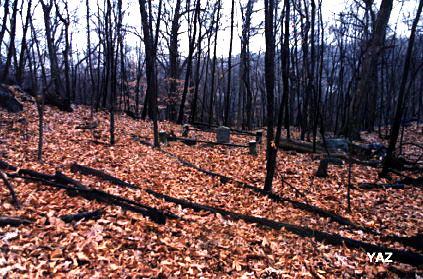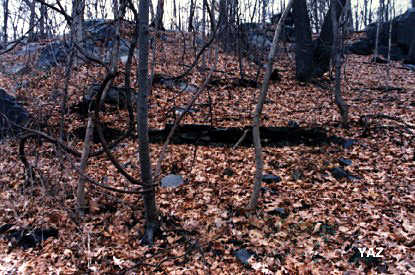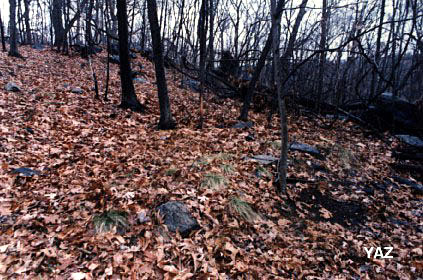
The Hermit's Grave

"Johann Stolting was a familiar figure as
he walked along Irvington' streets during the 1880's. His clothes he made
himself. His shoes were little more than sandals. No one remembered that
he ever wore a hat of any sort. He was fond of children and they were fond
of him, and he was not unsociable with the few neighbors who shared the
hillside on which he had built his cabin overlooking the Saw Mill River
Valley."
-"Wolfert's Roost"
|
|
JOHANN W. STOLTING NATIVE OF THE ISLE HELIGOLAND BORN 1810 DIED JAN. 10 1888 |
"No one knows for sure of his past. He is
said to have been born on Heligoland where he spent his youth. He was well
educated and migrated to this country and for a time taught languages.
Whatever the reasons, his eccentricities grew. He provided for the few
necessitites of life by turning out wooden buttons that he made on a
homemade lathe that he operated by foot power, and sold the product around
the village."
-"Wolfert's Roost"

Foundation ruins of the Hermit's cabin.
He had found the life that suited him
and he was farsighted enough to ensure that its end would be as he would
have it. He had his own coffin made of local chestnut wood and used it as
his bed for a number of years before it assumed its eternal function."
-"Wolfert's Roost"

Foundation of the Hermit's Toolshed.
"His grave is only a few hundred feet
west of the Saw Mill Parkway, which was deliberatley swerved in the
vicinity to avoid disturbing it-the only marked grave in the village of
Irvington."
-"Wolfert's Roost"
Excerpts were taken from Wolfert's Roost, Portrait of a
Village/Irvington-on-Hudson.
The Washington Irving Press,
Irvington-on-Hudson. 1971.
The Leatherman, a contemporary of The Hermit.
Copyright © 1997 by Robert J. Yasinsac. All rights reserved. All photographs are copyrighted.